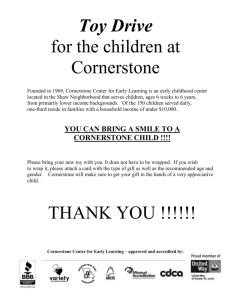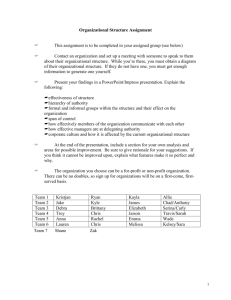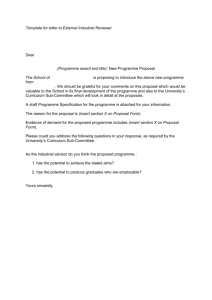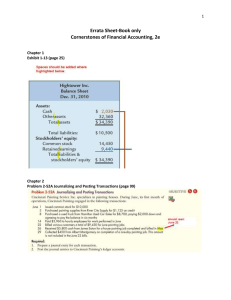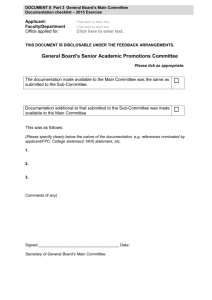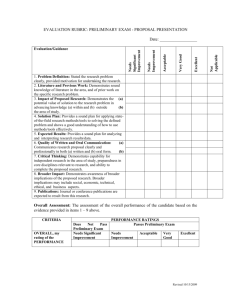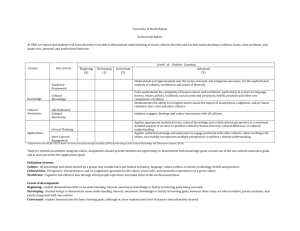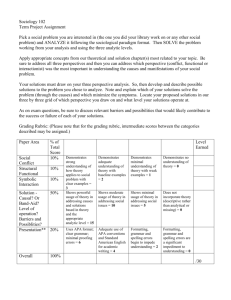Sample Assessment Report Cornerstone Assessment Report: Spring 2012 Rhetorical Analysis
advertisement
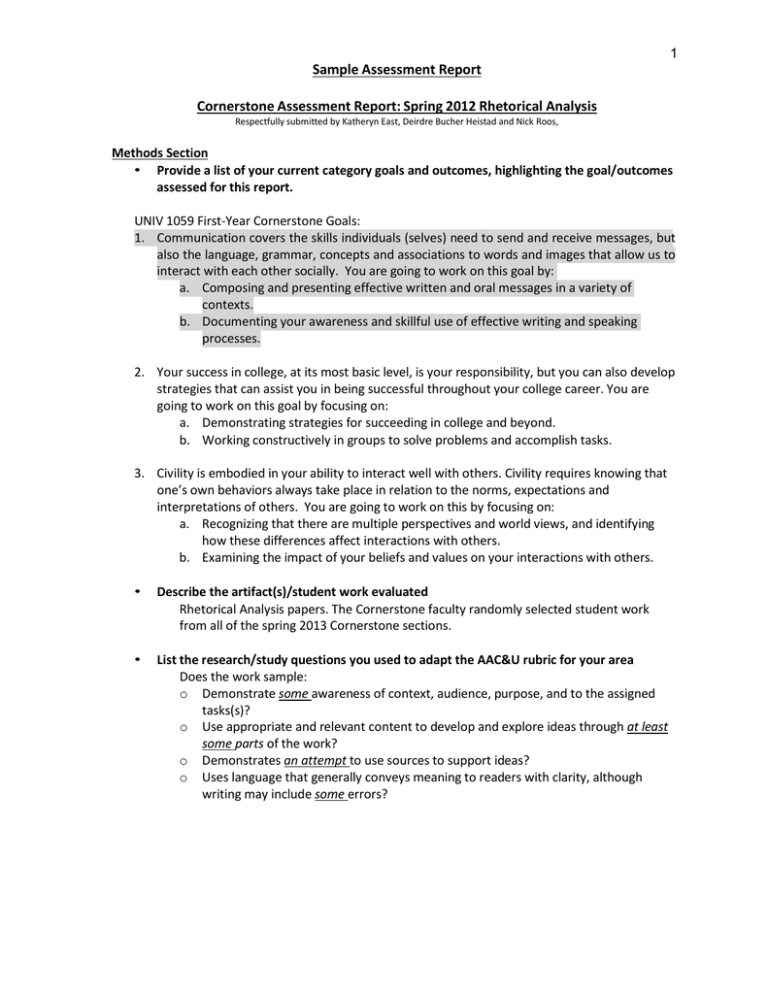
Sample Assessment Report 1 Cornerstone Assessment Report: Spring 2012 Rhetorical Analysis Respectfully submitted by Katheryn East, Deirdre Bucher Heistad and Nick Roos, Methods Section • Provide a list of your current category goals and outcomes, highlighting the goal/outcomes assessed for this report. UNIV 1059 First-Year Cornerstone Goals: 1. Communication covers the skills individuals (selves) need to send and receive messages, but also the language, grammar, concepts and associations to words and images that allow us to interact with each other socially. You are going to work on this goal by: a. Composing and presenting effective written and oral messages in a variety of contexts. b. Documenting your awareness and skillful use of effective writing and speaking processes. 2. Your success in college, at its most basic level, is your responsibility, but you can also develop strategies that can assist you in being successful throughout your college career. You are going to work on this goal by focusing on: a. Demonstrating strategies for succeeding in college and beyond. b. Working constructively in groups to solve problems and accomplish tasks. 3. Civility is embodied in your ability to interact well with others. Civility requires knowing that one’s own behaviors always take place in relation to the norms, expectations and interpretations of others. You are going to work on this by focusing on: a. Recognizing that there are multiple perspectives and world views, and identifying how these differences affect interactions with others. b. Examining the impact of your beliefs and values on your interactions with others. • Describe the artifact(s)/student work evaluated Rhetorical Analysis papers. The Cornerstone faculty randomly selected student work from all of the spring 2013 Cornerstone sections. • List the research/study questions you used to adapt the AAC&U rubric for your area Does the work sample: o Demonstrate some awareness of context, audience, purpose, and to the assigned tasks(s)? o Use appropriate and relevant content to develop and explore ideas through at least some parts of the work? o Demonstrates an attempt to use sources to support ideas? o Uses language that generally conveys meaning to readers with clarity, although writing may include some errors? 2 • Attach a copy of the rubric(s) you used to analyze the student work AAC&U WRITTEN COMMUNICATION VALUE RUBRIC (MODIFIED) Context of and Purpose for Writing Includes considerations of audience, purpose, and the circumstances surrounding the writing task(s). C-stone note: Includes thesis or statement of purpose Content Development C-stone note Intro/Conc. “balance among ideas/sections) Sources and Evidence Control of Syntax and Mechanics C-stone notes: Appropriate use of passive Use of 1st person Capstone 4 Demonstrates a thorough understanding of context, audience, and purpose that is responsive to the assigned task(s) and focuses all elements of the work. Uses appropriate, relevant, and compelling content to illustrate mastery of the subject, conveying the writer's understanding, and shaping the whole work. Demonstrates skillful use of highquality, credible, relevant sources to develop ideas that are appropriate for the discipline and genre of the writing Uses graceful language that skillfully communicates meaning to readers with clarity and fluency, and is virtually error-free. 3 Moderate Demonstrates adequate consideration of context, audience, and purpose and a clear focus on the assigned task(s) (e.g., the task aligns with audience, purpose, and context). 2 Demonstrates awareness of context, audience, purpose, and to the assigned tasks(s) (e.g., begins to show awareness of audience's perceptions and assumptions). Benchmark 1 Demonstrates minimal attention to context, audience, purpose, and to the assigned tasks(s) (e.g., expectation of instructor or self as audience). Uses appropriate, relevant, and compelling content to explore ideas within the context of the discipline and shape the whole work. Uses appropriate and relevant content to develop and explore ideas through most of the work. Uses appropriate and relevant content to develop simple ideas in some parts of the work. Demonstrates consistent use of credible, relevant sources to support ideas that are situated within the discipline and genre of the writing. Uses straightforward language that generally conveys meaning to readers. The language in the portfolio has few errors. Demonstrates an attempt to use credible and/or relevant sources to support ideas that are appropriate for the discipline and genre of the writing. Demonstrates an attempt to use sources to support ideas in the writing. Uses language that generally conveys meaning to readers with clarity, although writing may include some errors. Uses language that sometimes impedes meaning because of errors in usage. 4 Results Section (2-page maximum) Provide a visual that summarizes the results Context /Purpose Content Development Sources/ Evidence Syntax/Mechanics Overall 19.00 1.50 1.33 1.50 1.50 1.46 16a 1.50 1.50 1.50 1.83 1.58 10b 1.00 1.16 1.00 1.50 1.17 Visual 1 Rhetorical Analysis Averaged Assessment Scores 15a 1.50 1.17 0.17 1.67 1.13 6a 1.17 1.17 0.33 1.17 0.96 1a 1.67 1.17 1.17 2.00 1.50 5a 1.33 1.33 0.00 2.00 1.17 4a 1.83 1.83 1.50 1.33 1.62 9b 1.83 2.33 2.33 1.67 2.04 21a 1.67 1.50 1.17 2.00 1.59 11a 2.50 2.50 0.00 2.17 1.79 7a 1.67 1.83 1.83 2.00 1.83 17b 1.83 1.67 1.67 2.00 1.79 8a 1.83 1.67 1.50 1.67 1.67 Visual 2 Rhetorical Analysis (fall 2012) Averaged Assessment Scores Summary 2 1.8 1.6 1.4 1.2 1 0.8 0.6 0.4 0.2 0 Context/Purpose Content Development Sources/Evidence Syntax/Mechanics 14a 1.50 1.00 1.67 1.67 1.67 13b 2.17 1.67 2.17 1.83 1.96 12c 2.00 2.00 1.83 1.83 1.92 Student Average 3a 1.83 1.69 1.83 1.59 2.00 1.30 1.67 1.75 1.83 1.59 Provide a narrative of your finding A three member assessment sub-committee of the Cornerstone faculty evaluated 18 randomly selected Rhetorical Analyses that were submitted in fall 2012. The modified AAC&U Written Communication VALUE rubric was applied by each member of the assessment sub-committee to each paper. The faculty decided that it would be acceptable to include .5 increments in the 4 point scale. Minimal acceptable proficiency was determined to be 1 point on the 4 point scale. The subcommittee felt that this was the minimal proficiency that would be acceptable in the final draft of a paper written by a first year Cornerstone student. With that said, given the nature of the assignment and the process through which the students created the final draft, the desired result was that most students would achieve a score of 1.5 or higher overall and in each of the subcategories. The results indicate that overall average of the assessed papers was 1.59. In a similar vein, three of the four sub-category scores were also above the anticipated 1.5 score with 1.69 for Content and Purpose, 1.59 for Content Development and 1.75 for Syntax/Mechanics. However, the average score for Sources/Evidence was 1.30 which in this context appears significantly lower than the others. Impact Section (1-page maximum) Describe the collaboratively agreed upon changes, specific next steps, timetable for implementation of changes and re-assessment The assessment sub-committee was not surprised by the overall results. Never was there an instance when a paper was deemed deficient in more than one area. In fact, the only area of deficiency was the sub-category of Sources/Evidence. To better understand the nature of this perceived deficiency, we recommend that the Cornerstone faculty as a whole review the requirements for this common assignment. It may be that a simple difference in faculty expectations would explain this perceived deficiency. While the overall papers were deemed proficient, the assessment sub-committee invites the faculty of the whole to consider the following observations when discussion these assessment findings in relation to the overall assessment of the course. • While the sub-committee expectation was that this assignment was deemed as common throughout the multiple sections of Cornerstone, the papers did not read as such. One of the areas of difference had to do with whether or not the student was providing a textual or visual analysis. While some of the assignments obviously included reading, others did not. The faculty should reach some type of consensus regarding the role of reading and in particular close reading in regards to this assignment. • The sub-committee was left wondering to what extent the students were, as a whole, prepared to do this type of assignment. Is this assignment too difficult for students this early in the semester? Would it be beneficial for the students to practice via visual analyses of advertisements (low stakes in class practice, for example) before engaging in what appeared to be the more difficult task of textual analysis. • The sub-committee looks forward to discussing these results at our August workshop as we finalize the Cornerstone assignments for next year.
